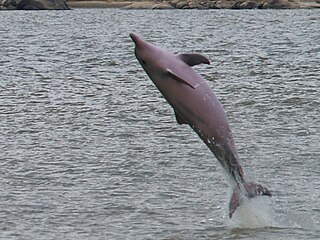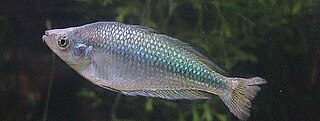
Perch is a common name for freshwater fish from the genus Perca, which belongs to the family Percidae of the large order Perciformes. The name comes from Greek: πέρκη, romanized: perke, meaning the type species of this genus, the European perch.

The tucuxi, alternatively known in Peru bufeo gris or bufeo negro, is a species of freshwater dolphin found in the rivers of the Amazon basin. The word tucuxi is derived from the Tupi language word tuchuchi-ana, and has now been adopted as the species' common name. Despite being found in geographic locations similar to those of 'true' river dolphins such as the boto, the tucuxi is not closely related to them genetically. Instead, it is classed in the oceanic dolphin family (Delphinidae).

Mayaca is a genus of flowering plants, often placed in its own family, the Mayacaceae. In the APG II system of 2003, it is assigned to the order Poales in the clade commelinids. The Cronquist system, of 1981, also recognised such a family and placed it in the order Commelinales in the subclass Commelinidae.

The European perch, also known as the common perch, redfin perch, big-scaled redfin, English perch, Euro perch, Eurasian perch, Eurasian river perch, Hatch, poor man's rockfish or in Anglophone parts of Europe, simply the perch, is a predatory freshwater fish native to Europe and North Asia. It is the type species of the genus Perca.

The European river lamprey, also known as the river lamprey or lampern, is a species of freshwater lamprey.

Theodoxus fluviatilis, common name the river nerite, is a species of small freshwater and brackish water snail with a gill and an operculum, an aquatic gastropod mollusk in the family Neritidae, the nerites.

The glittering-throated emerald is a species of hummingbird in the "emeralds", tribe Trochilini of subfamily Trochilinae. It is found in Bolivia, Brazil, Colombia, Ecuador, the Guianas, Peru, Trinidad and Venezuela.

The river limpet is a species of very small, freshwater, air-breathing limpet, an aquatic pulmonate gastropod mollusk in the tribe Ancylini within the family Planorbidae, the ram's horn snails and their allies.

The monkey goby is a species of goby native to the basins of the Black Sea and the Sea of Azov.

Theodoxus is a genus of nerites, small water snails with an operculum, some of which live in freshwater, and some in both freshwater and brackish water, aquatic gastropod mollusks in the family Neritidae, the nerites.

The Murray River rainbowfish, known less commonly as the Australian rainbowfish, is a species of freshwater fish endemic to southeastern Australia. The southernmost species of all rainbowfishes, these fish are very colourful, hence the name; and there is sexual dimorphism with the males being larger and more colourful than females. Murray River rainbowfish are schooling fish and will congregate near logs or riverbanks, and are a popular aquarium fish.

The green pufferfish or Ceylon pufferfish is a species of pufferfish found in South and Southeast Asia. Its habitat includes rivers, estuaries, lakes and flood plains. It lives in fresh to slightly brackish water.

Myrmekiaphila is a genus of North American mygalomorph trapdoor spiders in the family Euctenizidae, and was first described by G. F. Atkinson in 1886. All described species are endemic to the southeastern United States.

Bolboschoenus fluviatilis, the river bulrush, is a species of flowering plant in the sedge family, Cyperaceae. Its range includes Australia, New Zealand, New Caledonia, Canada, the United States, and northeastern Mexico. B. fluviatilis and its fruits are important as food sources for waterfowl such as geese, ducks, bitterns, and swans. It also provides cover and nesting sites for these and other species of birds, as well as small mammals. Like other Bolboschoenus species, B. fluviatilis has strong tubers and rhizomes which help to stabilize intertidal habitats by preventing erosion.

The dolphin genus Sotalia is considered to have two member species with the classification of Sotalia guianensis as a distinct species from Sotalia fluviatilis in 2007. This was a result of recent morphometric analyses, as well as mitochondrial DNA analysis.

Grevillea neurophylla, commonly known as granite grevillea, is a species of flowering plant in the family Proteaceae and is endemic to south-eastern continental Australia. It is a spreading to erect shrub with linear leaves, and clusters of white to pale pink flowers with a strongly hooked style.

The Guiana dolphin, also known as the estuarine dolphin or costero, is a dolphin found in the coastal waters to the north and east of South America, and east of Central America. It is a member of the oceanic dolphin family (Delphinidae). It can live in both saltwater and freshwater.

Isotoma fluviatilis, the swamp isotome or blue star creeper, is a small herbaceous perennial plant in the family Campanulaceae, native to Australia.
Prosthecobacter is a genus of bacteria from the phylum Verrucomicrobiota with a distinctive characteristic; the presence of tubulin-like genes. Tubulins, which are components of the microtubule, have never been observed in Gracilicutes before.
Prosthecobacter algae is a Gram-negative, facultatively anaerobic and fusiform-shaped bacterium from the genus Prosthecobacter which has been isolated from activated sludge.















